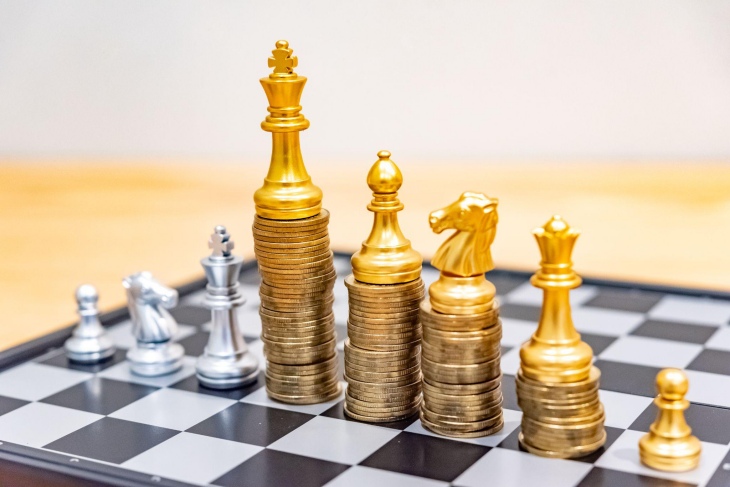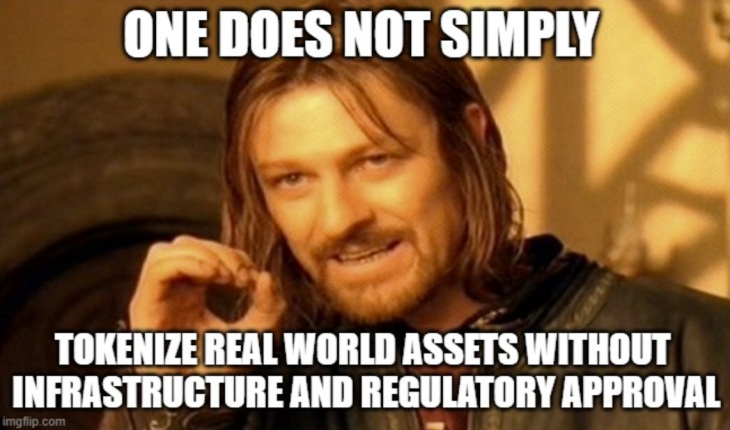
Tokenization is where we bundle commodities, real estate, or other financial assets into blockchain-based tokens, so they can be traded on crypto exchanges. It’s a way to transform real-world assets into crypto assets; another way that DeFi is becoming integrated with TradFi.
Our view is that everything is going to get tokenized. Anything of value will get turned into crypto tokens that can be bought, sold and traded, which has huge implications for investors.
I’ve written before about the tokenization of real-world assets, so it only made sense for me to delve more deeply into the recent Federal Reserve paper on tokenization (read it here). I found a narrative that shows the Fed is taking tokenization seriously, as well as its transformative potential for investors.
In today’s piece, I unravel the implications of tokenization for crypto investors, the opportunities it presents, and the speculative future hinted at by the Fed.
Tokenized Gold
With roughly $2.15 billion in tokenized assets on permissionless blockchains as of May 2023, gold shines brightest, with nearly half being tokenized gold. This makes the golden path of tokenization both a metaphor and a tangible reality, locking gold in the digital realm, and creating a bridge between the tangible and the intangible.
The Fed paper highlights the significant presence of tokenized gold, a market with a capitalization hovering around $1 billion as of May 2023. It’s a domain dominated by Pax Gold (PAXG) and Tether Gold (XAUt), with the two controlling 99% of the market. These digital representations of gold are not merely reflections of reality but are fully redeemable, allowing holders to claim the underlying physical gold, albeit with certain restrictions and fees.
For digital investors, this opens up a realm of possibilities and considerations. The ability to own and trade tokenized gold offers a unique blend of liquidity and stability. However, it’s a journey that requires nerves of steel, careful consideration of the redeemability features, and an understanding of the inherent risks and benefits.
The trajectory of tokenized commodities is a testament to the evolving dynamics of the investment world. It’s a path paved with golden opportunities but also with speculative uncertainties. Will tokenization improve investor access to gold, or will the complexities of crypto technology hamper its growth?
Tokenized Real Estate
Gold isn’t the only tokenized asset class. Tokenized real estate is also growing, allowing us to build real estate wealth, one token at a time.

The paper mentions Real Token Inc. (RealT) as a pioneer in crafting digital representations of legal rights on residential properties. Each property, a unique entity owned by a legally independent LLC, allows investors to own a slice of domestic US real estate and enjoy the benefits of rental income. As of September 2022, RealT had successfully tokenized 970 property units, amassing a value of over $52 million.
This innovative approach to real estate investment is not just a revolutionary concept, but a gateway to diversified portfolios. It brings an asset class that is traditionally out of reach into arm’s length.
However, the path has its challenges. The less uniform nature of real estate assets and intricate legal and tax processes pose significant hurdles in real estate tokenization. It’s a journey that weaves between innovation and regulation, where every step forward is a delicate balance between opportunity and constraint.
Tokenized Stocks, Bonds, and ETFs
The Federal Reserve report also looks at the tokenization of intangible assets like stocks, bonds, and ETFs. Like real estate and gold, imagine owning not the stocks and bonds themselves, but digital tokens representing ownership of the underlying asset.
The document notes that tokenized stocks and their real-life counterparts offer similar economic exposures, but a sometimes different experience for investors, with price variations due to distinct trading hours and intrinsic properties. Notably, the programmability in DeFi applications expands the reach of traditional financial instruments.
For crypto investors, tokenized financial assets will be used as composable building blocks, meaning you’ll be able to lend, borrow, or hedge against them using DeFi platforms, just as you do with Ethereum-based crypto assets today. Over time, DeFi and TradFi will become indistinguishable.
The Benefits of Tokenization
The Fed paper admits that tokenization offers many benefits to investors and markets. It grants access to otherwise inaccessible or costly markets, such as real estate, allowing investors to own fractions of specific assets, contrasting with the broader portfolio ownership in REITs.
The inherent programmability of crypto tokens and the utilization of smart contracts enable the embedding additional features in tokenized assets, potentially benefiting the markets of the underlying reference assets by implementing liquidity-saving mechanisms and facilitating better price discovery.
These innovations help to lower entry barriers, inviting a broader spectrum of investors and fostering more competitive and liquid markets. Tokenization also enhances lending mechanisms, using tokens as collateral where traditional methods may be costly or unfeasible, and ensures quicker settlement of transactions compared to their real-world counterparts and traditional securities settlement systems.
Drawing parallels with ETFs, empirical evidence suggests a positive correlation between the liquidity of ETFs and their underlying securities, enhancing information efficiency. A similar dynamic for tokens could imply that increased liquidity in crypto markets may lead to more accurate pricing for the token’s reference assets, thereby improving the liquidity and efficiency of the markets for the reference assets.

Potential Implications for Financial Stability
While tokenized markets’ current value is relatively small compared to traditional financial markets, tokenization could introduce vulnerabilities to global markets. Tokenization creates interconnections between the digital and traditional financial systems, potentially transmitting shocks from crypto markets to asset markets, especially when these assets aren’t liquid, like real estate.
One significant concern is the transmission of volatility due to the 24/7 trading of crypto assets compared to the limited trading hours of most reference asset markets. This mismatch could lead to unpredictable implications during stress events, such as fire sales of tokenized assets, affecting the solvency of institutions holding substantial shares of the tokenized asset.
Tokenized assets with redemption options, like collateralized stablecoins, could suffer from runs on the issuer due to uncertainties surrounding the tokens’ collateralization levels. This is particularly true when the issuer lacks transparency. The growth of tokenizations also exposes traditional financial institutions to crypto asset markets by directly owning tokenized assets or using tokens as collateral for other financial instruments.
Ondo Finance’s journey into tokenizing U.S. government money market funds on Ethereum shows the potential wider range of use cases for tokenization, impacting traditional financial markets. Tokenization can disguise riskier or illiquid reference assets as safe and easily tradable, encouraging higher leverage and risk-taking, which could trigger systemic events in the case of a sudden reversal of these positions.
Investor Takeaway
Tokenized assets are coming. From the allure of tokenized gold, to plots of tokenized real estate, to baskets of financial assets, the Fed acknowledges that tokenized assets are the future, which brings both perils and promise.

While the paper’s authors strike a cautious note, I believe that we should look at tokenization as a journey toward the future. As investors, we should embrace the transformative potential, and look for new opportunities and strategies that tokenized real-world assets will bring us.
Let’s be the pioneers of this new frontier, exploring wealth-building opportunities, one token at a time.

